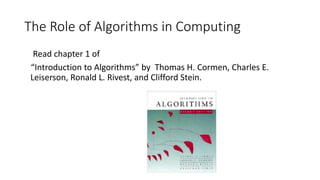
The Role of Algorithms in Computing and Problem Solving
- 1. The Role of Algorithms in Computing Read chapter 1 of “Introduction to Algorithms” by Thomas H. Cormen, Charles E. Leiserson, Ronald L. Rivest, and Clifford Stein.
- 2. Computational problems • A computational problem specifies an input- output relationship • What does the input look like? • What should the output be for each input? • Example: • Input: an integer number n • Output: Is the number prime? • Example: • Input: A list of names of people • Output: The same list sorted alphabetically
- 3. Algorithms • A tool for solving a well-specified computational problem • Algorithms must be: • Correct: For each input produce an appropriate output • Efficient: run as quickly as possible, and use as little memory as possible – more about this later Algorithm Input Output
- 4. Algorithms Cont. • A well-defined computational procedure that takes some value, or set of values, as input and produces some value, or set of values, as output. • Written in a pseudo code which can be implemented in the language of programmer’s choice.
- 5. Correct and incorrect algorithms • Algorithm is correct if, for every input instance, it ends with the correct output. We say that a correct algorithm solves the given computational problem. • An incorrect algorithm might not end at all on some input instances, or it might end with an answer other than the desired one. • We shall be concerned only with correct algorithms.
- 6. Problems and Algorithms • We need to solve a computational problem • “Convert a weight in pounds to Kg” • An algorithm specifies how to solve it, e.g.: • 1. Read weight-in-pounds • 2. Calculate weight-in-Kg = weight-in-pounds * 0.455 • 3. Print weight-in-Kg • A computer program is a computer-executable description of an algorithm
- 8. From Algorithms to Programs Problem C++ Program Algorithm: A sequence of instructions describing how to do a task (or process)
- 9. Pseudo-code conventions Algorithms are typically written in pseudo-code that is similar to C/C++ • Pseudo-code differs from real code with: • It is not typically concerned with issues of software engineering. • Issues of data abstraction, and error handling are often ignored. • Indentation indicates block structure. • The symbol "▹" indicates that the remainder of the line is a comment. • A multiple assignment of the form i ← j ← e assigns to both variables i and j the value of expression e; it should be treated as equivalent to the assignment j ← e followed by the assignment i ← j.
- 10. Pseudo-code conventions • Variables ( such as i, j, and key) are local to the given procedure. We shall not us global variables without explicit indication. • Array elements are accessed by specifying the array name followed by the index in square brackets. For example, A[i] indicates the ith element of the array A. The notation “…" is used to indicate a range of values within an array. Thus, A[1…j] indicates the sub-array of A consisting of the j elements A[1], A[2], . . . , A[j]. • A particular attributes is accessed using the attributes name followed by the name of its object in square brackets. • For example, we treat an array as an object with the attribute length indicating how many elements it contains( length[A]).
- 12. Divide-and-Conquer The most-well known algorithm design strategy: 1. Divide instance of problem into two or more smaller instances 2. Solve smaller instances recursively 3. Obtain solution to original (larger) instance by combining these solutions
- 13. Divide-and-Conquer Technique (cont.) subproblem 2 of size n/2 subproblem 1 of size n/2 a solution to subproblem 1 a solution to the original problem a solution to subproblem 2 a problem of size n (instance) It general leads to a recursive algorithm!
- 14. Divide-and-Conquer Examples • Sorting: mergesort and quicksort • Binary tree traversals • Binary search (?) • Multiplication of large integers • Matrix multiplication: Strassen’s algorithm • Closest-pair and convex-hull algorithms
- 15. Divide-and-Conquer Algorithm- An example A small example: A B where A = 2135 and B = 4014 A = (21·102 + 35), B = (40 ·102 + 14) So, A B = (21 ·102 + 35) (40 ·102 + 14) = 21 40 ·104 + (21 14 + 35 40) ·102 + 35 14 In general, if A = A1A2 and B = B1B2 (where A and B are n- digit, A1, A2, B1, B2 are n/2-digit numbers), A B = A1 B1·10n + (A1 B2 + A2 B1) ·10n/2 + A2 B2